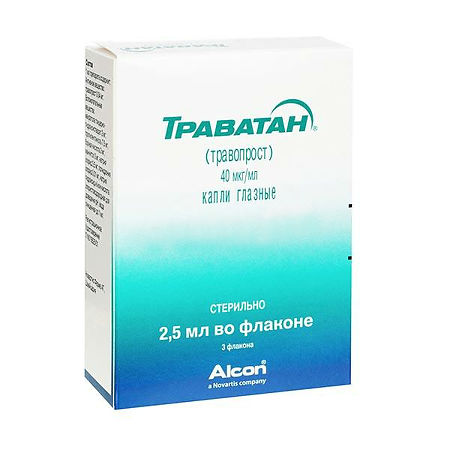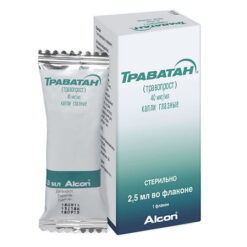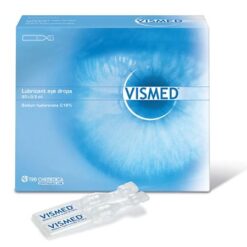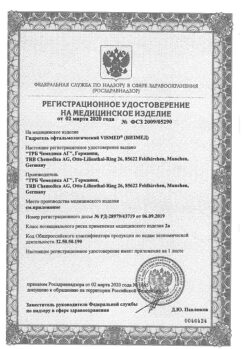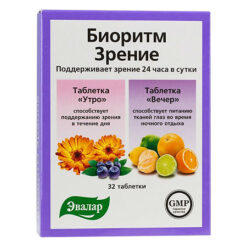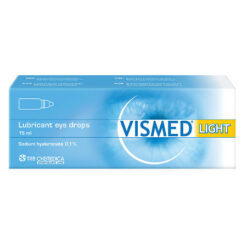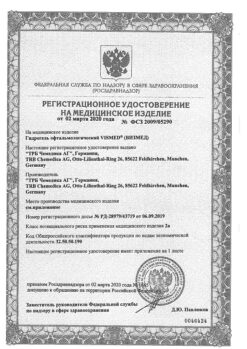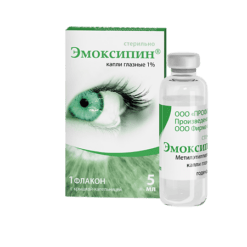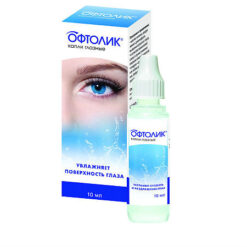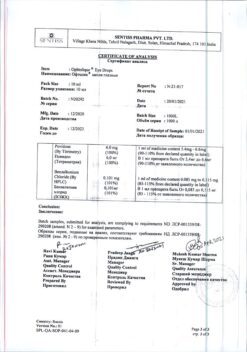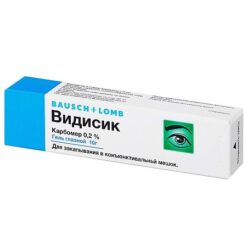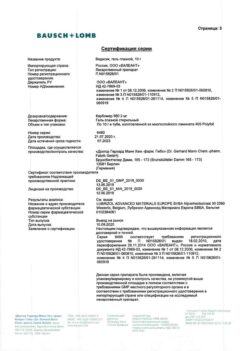No products in the cart.
Travatan, eye drops 40 mcg/ml 2.5 ml 3 pcs.
€64.88 €56.23
Description
Reduction of elevated intraocular pressure in:
– Open-angle glaucoma;
– Increased ophthalmotonus.
Indications
Indications
Reducing elevated intraocular pressure with:
– open-angle glaucoma;
– increased ophthalmotonus.
Pharmacological effect
Pharmacological effect
Pharmacodynamics
Special instructions
Special instructions
Changing eye color
Travatan® may cause a gradual change in eye color by increasing the number of melanosomes (pigment granules) in melanocytes. This effect is detected mainly in patients with mixed iris color, for example, blue-brown, gray-brown, green-brown or yellow-brown. This effect was also noted in patients with brown irises. Typically, brown pigmentation extends concentrically around the pupil to the periphery of the iris, and the entire iris or parts of it may become a more intense brown color.
The long-term effect on melanocytes and the consequences of this influence are currently unknown. Changes in iris color occur slowly and may go unnoticed for months or years. Before starting treatment, patients should be informed about the possibility of permanent changes in eye color. If only one eye is treated, persistent heterochromia may develop. After completion of travoprost therapy, no further increase in brown pigmentation of the iris was observed.
Changes in the skin of the periorbital area and eyelids
In controlled clinical studies, darkening of the skin of the periorbital area and/or eyelids was observed with Travatan® in 0.4% of patients. Travatan® can gradually change the eyelashes on the eye that
was treated; These changes include increased length, thickness, increased pigmentation, and/or increased number of eyelashes. The mechanism of these changes, as well as their impact on the long-term safety of the drug, has not yet been established.
Changes in the orbital region and eyelids, including deepening of the eyelid sulcus, have been noted with the use of prostaglandin analogues. Information about such changes in the periorbital region was obtained during studies in monkeys and was not noted during clinical studies in humans, which allows us to consider this effect to be species specific.
There is no experience with the use of Travatan® in the treatment of inflammatory diseases of the organ of vision, neovascular glaucoma, closed-angle glaucoma, in patients with narrow-angle glaucoma or congenital glaucoma. Limited data are available on the use of the drug in the treatment of ocular manifestations of thyroid diseases, open-angle glaucoma with concomitant pseudophakia, pigmentary glaucoma, pseudoexfoliative glaucoma.
Aphakic patients
Macular edema has been observed during treatment with prostaglandin F2α analogues.
Skin contact
It is necessary to avoid contact of the drug with the skin, because Transdermal absorption of travoprost was demonstrated in experiments on rabbits.
Contact lenses
Before using Travatan®, contact lenses should be removed and reinserted no earlier than 15 minutes after using the drug.
Excipients
The drug contains propylene glycol, which may cause skin irritation.
The drug contains macrogol glyceryl hydroxystearate, which may cause skin reactions.
Use in pediatrics
Information on the effectiveness and safety of the drug in the age group from 2 months to 3 years and older is limited. Information on the use of the drug in patients under 2 months of age is not available. In patients older than 3 years, who most often receive antihypertensive therapy for primary congenital glaucoma, surgical treatment (trabeculotomy/goniotomy) remains the first-line treatment. There is no information on the long-term safety of the drug in the pediatric population.
Precautions
Do not touch the tip of the dropper bottle to any surface to avoid contamination of the dropper bottle and its contents.
The bottle must be closed after each use.
Impact on the ability to drive vehicles and operate machinery
Temporary blurred vision or other visual disturbances after taking this drug may affect your ability to drive or operate machinery. If blurred vision occurs after instillation of the drug, then the patient must wait until clear vision is restored before driving a vehicle or operating machinery.
Active ingredient
Active ingredient
Travoprost
Composition
Composition
active substance:
travoprost
0.04 mg
excipients: macrogol glyceryl hydroxystearate – 2 mg; propylene glycol – 7.5 mg; boric acid – 3 mg; mannitol – 3 mg; sodium chloride – 3.5 mg; polydronium chloride – 0.01 mg; sodium hydroxide and/or hydrochloric acid – to adjust the pH; purified water – up to 1 ml
Contraindications
Contraindications
– pregnancy;
– lactation period (breastfeeding);
– children and adolescents up to 18 years of age;
– hypersensitivity to the components of the drug.
The drug should be prescribed with caution to patients with aphakia; pseudophakia due to rupture of the posterior capsule of the lens or anterior chamber intraocular lens; risk of developing cystoid macular edema; acute inflammatory phenomena of the organ of vision, as well as patients at risk of developing iritis, uveitis.
Side Effects
Side Effects
According to clinical studies, the most common adverse events were conjunctival injection and iris hyperpigmentation, the incidence rates being 20% and 6%, respectively.
The frequency of occurrence of adverse reactions is given in accordance with the following classification: very often (≥1/10), often (from ≥1/100 to <1/10), infrequently (from ≥1/1,000 to <1/100), rarely (from ≥1/10,000 to <1/1000), very rarely (<1/10,000), frequency unknown. Within each adverse event frequency group, adverse events are presented in decreasing order of severity. Information about adverse events was obtained during clinical trials and post-registration surveillance.
Infectious and parasitic diseases: rarely – herpetic keratitis, infection caused by Herpes simplex.
From the immune system: infrequently – hypersensitivity, seasonal allergies.
Mental disorders: frequency unknown – depression, anxiety.
From the nervous system: infrequently – headache, dizziness; rarely – dysgeusia.
From the side of the organ of vision: very often – conjunctival injection; often – hyperpigmentation of the iris, eye pain, eye discomfort, dry eye syndrome, eye irritation; uncommon – corneal erosion, uveitis, iritis, keratitis, punctate keratitis, photophobia, blepharitis, discharge from the eyes, erythema of the eyelids, swelling of the periorbital region, itching of the eyelids, decreased visual acuity, blurred vision, lacrimation, conjunctivitis, ectropion, cataracts, crusts on the edges of the eyelids, increased eyelash growth, discoloration of eyelashes, asthenopia; rarely – photopsia, eczema of the eyelids, conjunctival edema, the appearance of rainbow circles around light sources, conjunctival folliculosis, eye hypoesthesia, meibomitis, pigment dispersion in the anterior chamber of the eye, mydriasis, thickening of eyelashes; frequency unknown – macular edema, retraction of the eyeballs.
From the organ of hearing and labyrinthine disorders: frequency unknown – vertigo, tinnitus.
From the cardiovascular system: infrequently – palpitations; rarely – irregular heartbeat, decreased heart rate; rarely – decreased diastolic blood pressure, increased systolic blood pressure, hypotension, hypertension; frequency unknown – chest pain, bradycardia, tachycardia.
From the respiratory system: infrequently – dyspnea, asthma, nasal congestion, irritation in the throat; rarely – respiratory dysfunction, pain in the oropharynx, cough, dysphonia; frequency unknown – worsening of bronchial asthma.
From the digestive system: rarely – constipation, dry mouth, exacerbation of stomach ulcers, disruption of the gastrointestinal tract; frequency unknown – diarrhea, abdominal pain, nausea.
From the skin and subcutaneous tissues: uncommon – increased skin pigmentation in the periorbital area, skin discoloration, changes in the structure of vellus hair, hypertrichosis; rarely – allergic dermatitis, contact dermatitis, erythema, rash, discoloration of vellus hair, madarosis; frequency unknown – itching, abnormal growth of vellus hair.
From the musculoskeletal system: rarely – musculoskeletal pain; frequency unknown – arthralgia.
From the urinary system: frequency unknown – dysuria, urinary incontinence.
Laboratory data: frequency unknown – increase in total PSA.
Other: rarely – asthenia.
Profile of adverse events in pediatric practice
In a 3-month phase III study and a 7-day pharmacokinetic study in 102 pediatric patients, the adverse event profile was consistent with that observed in adult patients. Short-term safety profiles were also similar in different subpopulations of the pediatric population.
The most common adverse reactions in the pediatric population were conjunctival injection (16.9%) and increased eyelash growth (6.5%). In a similar 3-month study in adult patients, these adverse events occurred with a frequency of 11.4% and 0.0%, respectively. Additionally, isolated cases of eyelid erythema, keratitis, lacrimation and photophobia were observed in the pediatric population (n=77) during a 3-month clinical study similar to that of adult patients (n=185), with an overall incidence of adverse events of 1.3% compared with 0.0% in the adult population.
Interaction
Interaction
No clinically significant drug interactions have been described.
Overdose
Overdose
Toxicity from overdose when applied topically is unlikely.
Treatment: in case of accidental ingestion – symptomatic and supportive therapy. In case of overdose of the drug when applied topically, rinse the eyes with warm water.
Storage conditions
Storage conditions
The drug should be stored out of the reach of children at a temperature of 2° to 30°C. Shelf life – 2 years. Do not use after the expiration date indicated on the package.
Once the bottle is opened, the eye drops should be used within 4 weeks.
Manufacturer
Manufacturer
S.A. Alkon-Couvreur n.v., Belgium
Additional information
| Conditions of storage | The drug should be kept out of reach of children at 2° to 30°C. Shelf life – 2 years. Do not use after the expiration date stated on the package. The eye drops should be used within 4 weeks after opening the bottle. |
|---|---|
| Manufacturer | s.a. Alcon-Couvreur n.a., Belgium |
| Medication form | eye drops |
| Brand | s.a. Alcon-Couvreur n.a. |
Other forms…
Related products
Buy Travatan, eye drops 40 mcg/ml 2.5 ml 3 pcs. with delivery to USA, UK, Europe and over 120 other countries.

